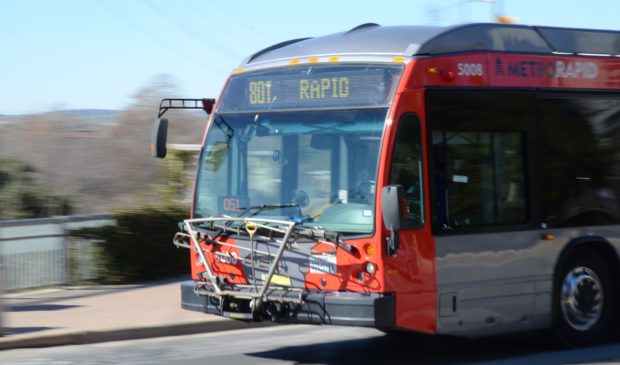Breakdowns plague MetroRapid fleet
Thursday, December 7, 2017 by
Caleb Pritchard The Capital Metropolitan Transportation Authority’s highly heralded MetroRapid buses fell well short of the agency’s maintenance goals during Fiscal Year 2016-17.
Each month, the fleet of 55 vehicles failed to reach the minimum goal of miles traveled between road calls.
“A road call happens anytime there’s a mechanical failure that requires the vehicle to be either repaired on the street or get changed out at the yard,” Dottie Watkins, Capital Metro’s vice president of bus and paratransit services, explained to the Austin Monitor.
On Wednesday, Watkins delivered her year-end operations report to the board of directors’ Operations, Planning and Safety Committee. Based on metrics such as on-time performance, crashes and customer complaints, Watkins reported that the overall customer satisfaction index across the agency’s various services – MetroBus, MetroRapid, MetroAccess and MetroRail – came in at 6.63 on a 10-point scale. The weak link, however, was MetroRapid, whose index was calculated at 5.64, largely due to its pervasive maintenance problem.
The agency set MetroRapid’s bar at 5,500 miles between road calls. In the 12 months between October 2016 and September 2017, the closest the enhanced service came to achieving that goal was in April, when the fleet went 4,598 miles between calls. The worst month was June, when a bus broke down every 2,938 miles.
Capital Metro awarded MV Transportation the contract to both operate and maintain a chunk of its fleet – including the MetroRapid buses – in 2015. The maintenance side of the arrangement costs the agency a fixed rate just shy of $350,000 per month, plus $53 for every hour each vehicle it maintains is on the road.
Watkins said that MV’s predecessor, First Transit, had underperformed in keeping its buses in working order. Since the shift, MV has managed to largely bring its fleet of Gillig-manufactured local buses back above the agency’s standards.
But the ongoing issues with the MetroRapid vehicles, made by Montreal-based Nova Bus, still remain something of a mystery.
“It’s really a bit of a sticky wicket to figure out exactly what’s going on with that fleet,” Watkins told the committee. “But that fleet is not old enough to be performing this poorly, and to be performing this poorly this consistently despite the overall good maintenance in that shop.”
Capital Metro launched 40 MetroRapid buses in 2014 when it inaugurated the new Nos. 801 and 803 routes. The agency added 15 vehicles to the fleet this year in order to increase frequencies and ultimately serve more stops.
“The 15 new vehicles are performing wonderfully. They’re performing in excess of 7,000 miles between road calls,” Watkins said. “But we continue to have performance issues on the original 40 vehicles.”
The agency purchased those buses with the help of a $38 million federal grant the agency brought down in 2012. Of the original fleet, the 22 60-foot articulated buses that operate along the No. 801 route have had more trouble than their 40-foot sisters on the No. 803 line.
While a specific diagnosis has yet to be made, one common denominator has been established.
“In general, the buses don’t like the heat,” she told the Monitor. “That tends to be an issue. No bus loves the heat, but these buses have been more problematic in the heat than not. We’re seeing engine wear occur faster on these buses than we would expect it to occur.”
According to Watkins, a typical bus that operates roughly 50,000 miles per year can be expected to log between 350,000 to 400,000 miles before its engine needs to be replaced. Several of the MetroRapid engines, however, gave out before they hit 200,000 miles.
Along with MV representatives, agency staff has convened biweekly meetings with Nova Bus and Cummins Inc., the maker of the engines, to discuss the problem and explore solutions. Watkins suggested that Nova Bus has a strong business incentive to get the buses back up to snuff.
“They want to be able to sell us buses the next time we need to buy them. And we buy buses just about every year,” she said. Indeed, Connections 2025, the agency’s 10-year service plan, calls for the eventual creation of two brand-new MetroRapid lines, which would require a significant expansion of the fleet.
But even if Capital Metro snubs Nova Bus for another bus maker, Cummins has little to fear. According to Watkins, the Indiana-based company is the only manufacturer in the entire country that produces transit vehicle engines approved by the federal Environmental Protection Agency.
Photo by John Flynn.
The Austin Monitor’s work is made possible by donations from the community. Though our reporting covers donors from time to time, we are careful to keep business and editorial efforts separate while maintaining transparency. A complete list of donors is available here, and our code of ethics is explained here.
You're a community leader
And we’re honored you look to us for serious, in-depth news. You know a strong community needs local and dedicated watchdog reporting. We’re here for you and that won’t change. Now will you take the powerful next step and support our nonprofit news organization?









